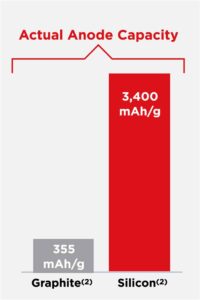Amprius has announced a 500 Watt-hour per kilogram cell, essentially doubling the energy density available up to now. Remember, though, that cell-levels of energy drop as the cells are incorporated into modules and packs, carrying the burdens of containment packaging, bus bars, and battery management systems (BMS) that lower total output. Pack levels will be lower.
Slow Progress
This comes as the culmination of at least 14 year’s work, starting with Yi Cui’s work at Stanford University. Your editor first saw him at a 2009 CAFE Foundation symposium at the Hiller Aviation Museum in San Carlos, California. He was a proponent of the 10X battery, which at that time would have meant 10 times the energy storage of then typical cells, or around 10 times the 200 Watt-hours per kilogram then considered to be a respectable achievement.

Amprius’ silicon anode achieves 10X the capacit4y of graphite
This blog reported in 2013, “According to Green Car Congress, ‘The company has also demonstrated greater than 650 and 700 Wh/L batteries with its second-generation and third-generation technology platforms. Amprius plans to begin pilot production of its second-generation batteries later this year. First-generation batteries are made with silicon anodes: silicon nanowire anodes will appear in the subsequent generations.’”
Amprius silicon anodes compared to other metals
These numbers a decade ago were probably for lab samples and not for commercially produced examples. The fact that other makers have not exceeded 272 to 296 kW-hrs. at the cell level (for the Tesla 4680 battery) shows the difficulty of achieving “breakthroughs” in battery development. Inside EVs explains, “The energy density of the cell is estimated then at 272-296 Wh/kg, which is very good and basically comparable to the best cells on the market.”
Proof of Endurance
Amprius has been shipping 450-Wh/kg. batteries for some time, but has recently announced verification of its 500 wh/kg, 1,300 Wh/L cells, “resulting in unparalleled run time.” This has already been demonstrated by Airbus subsidiary AALTO HAPS (High Altitude Pseudo Satellite), which produces the Zephyr.
Spreading the News
At the 10th Annual Electric VTOL Symposium in January of this year, Amprius presented a current look at its capabilities and their batteries’ applications in aircraft use. Their slide deck shows what “state of the art” represents at this time. Although there are batteries showing promise, they are in the future and Amprius is delivering now. As Amprius improves its cathodes and electrolytes to equal the performance of their anodes, who knows where this could lead?

